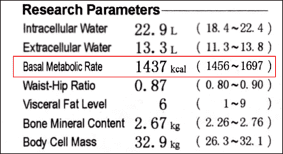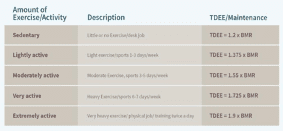You probably don’t think about your body composition when you’re thinking about your metabolism. But you should.
You probably think about it in terms of speed: “My metabolism is fast” or “my metabolism is slowing down.”
People are naturally afraid of their metabolism slowing and the weight gain they know comes with it. To some extent, those worries are well-founded.
Metabolism is linked with weight gain and loss because of its a biological process involved with energy and calories.
A well rounded and accepted definition of metabolism is: the process by which your body converts what you eat and drink into energy. During this complex biochemical process, calories in food and beverages are combined with oxygen to release the energy your body needs to function.
Notice how it doesn’t mention anything about the speed you process your food. That would be digestion.
In medical terminology, metabolism Basal Metabolic Rate (BMR), which is the minimum number of calories your body needs to perform basic bodily functions. This includes all the involuntary processes in your body such as breathing, digesting food, pumping blood, brain activity. BMR is usually expressed in terms of calories. Your Basal Metabolic Rate also has another interesting quality: the more Lean Body Mass (which includes muscle, water, and minerals) you have, the greater your BMR will be.
When we talk about metabolism, we should always start the conversation with how many calories your body needs. But because your BMR and Lean Body Mass are linked, that means any conversation about metabolism becomes a conversation about your body composition.

Your BMR is calculated when you have an InBody composition analysis. Having this available to you is a valuable tool when monitoring your body’s overall health changes.
Metabolism 101
Let’s take a deeper look at what you might call a “slow” metabolism. Far from being an issue of fastness or slowness, weight gain is almost always the result of a caloric imbalance that goes unchecked over a long period of time.
To clarify, your Basal Metabolic Rate is not the only factor that plays into your overall caloric needs, and it’s not the total amount of calories you need in a day. There are two other major influencers, which are:
- Your energy level–how active you are
- The thermic effect of food–the energy your body uses to digest your food
These taken together with your Basal Metabolic Rate provide your Total Daily Energy Expenditure (TDEE). This is the number of calories your body burns in a day.
BMR is a necessary piece of information to estimate TDEE. Although they’re not exact, there are multiplication factors for estimating your TDEE based on your activity level and BMR. These are based on multiplying your BMR with an activity factor–a number between 1 and 2–that increases the more active you are (and decreases when you are less active, regardless of your appetite).
The table below gives you multiplication factors to apply to your BMR to establish your TDEE. Using this information will assist in determining how many calories are required to maintain your current body weight.

In our previous example, the person has a BMR of 1437. They consider themselves to be moderately active. Therefore, their TDEE is 2227 calories. If weight loss is their goal, they work on fewer calories, if weight gain is what they’re after, then a surplus of calories will be required.
As with any dietary plan, you will expect to see changes over time. All this hard work has to produce results, right? So, how long will it take to see results? Unfortunately, that is going to vary for each individual. A good rule of thumb is to weigh yourself every 1 – 2 weeks. If you are looking for a more precise analysis, you should get your body composition measured as well. Another important factor to consider: your BMR. Since your BMR is closely linked to your lean body mass, any changes will affect the number of calories you burn.
For example, if your plan is to gain lean body mass, and over a period of time you are successful in doing so, your energy needs are going to increase. This is why it is so important to be measuring body composition.
A diet is much more than creating a calorie deficit. It’s important to use a BMR calculator or body composition analyser to understand how much energy your body needs. Without this information, you won’t know how much food you need to add or remove to your diet in order to achieve your goals. With this information, you’ll see quicker results and reach your goals faster.
Improving and Increasing Your Metabolism
With the correct exercise and dietary plan, you can make your metabolism work for you. It all goes back to improving and maintaining a healthy body composition.
Because your body needs more energy to support itself when it has more Lean Body Mass, working to increase your Lean Body Mass can actually increase your Basal Metabolic Rate, which can have a huge impact on your TDEE once you factor in your activity level.
Many people simply maintain their metabolism or avoid a “slowdown” (which as we’ve seen, is a myth right up there with muscle turning into fat) is an important goal. How can you be sure to stay away from creating a decrease in your metabolism?
In short: by maintaining the Lean Body Mass that you already have. That means maintaining your Skeletal Muscle Mass.
Your Skeletal Muscle Mass isn’t the same as your Lean Body Mass, but it is the overall biggest contributor to it. It’s the muscle that you can actually grow and develop through exercise, and increases/decreases in SMM have a strong influence on increases/decreases in Lean Body Mass.
Skeletal Muscle Mass is best developed through strength training and resistance exercise along with a proper diet. A regular exercise plan that includes strength training and resistance exercise will help you maintain your Skeletal Muscle Mass.
This can be especially important as you age. As people become older and busier, activity levels tend to drop and a proper diet can become harder to maintain as responsibilities increase. Poor diet and nutrition can lead to loss of Lean Body Mass over time, which leads to a decrease in overall metabolism–not a slowdown.
So what can be done to improve and increase your metabolic rate? Just like with most things in life, the key is finding your body’s perfect balance.
Balance Your Diet And Boost Your Metabolism – The Truth About Metabolic Flexibility
At times, a well-intentioned and thoughtful dietary plan doesn’t match the metabolism of the person practicing it. Even though someone may be led to believe that 1,800 calories is right for his or her diet regimen based on age and gender, our metabolisms might not require that caloric intake, ultimately resulting in weight gain despite our well-intended efforts.
In the end, most individuals will end up blaming their issues with weight loss on a “slowing metabolism,” illustrating the importance of understanding how the relationship between a balanced diet and body composition can actually lead to a boosted metabolism.
Contradicting health articles do not help the confusion. They preach that carbs should be eaten before you work out, as they will improve your performance. They also say to eat more fats like peanut butter or avocados. Others say that if you don’t eat at all, your body will burn more calories, and you should instead refuel with carbs or recover with protein to build muscle. Is your head spinning yet?
You’re not alone if you ever feel like every health article you see contradicts the one you saw the day before.
This is where the perpetual carbs-versus-fats debate comes into play. Everyone’s quick to tell you about their success with the Keto diet or how more balanced macros improved their performance in the gym.
In reality, there’s no perfect diet. Everyone’s preferred macronutrient ratio and calorie intake depend on their unique resting metabolic rate, activity level, food sensitivities, and more. But there is one thing everyone can count on:
Your body will – or should – use what you give it.
What is Metabolic Flexibility?

If you eat a lot of fats, fat will be your body’s primary source of fuel. If you eat a lot of carbohydrates, glucose will be your body’s primary source of fuel. If you eat more protein than anything else – you guessed it – your body will burn more protein for energy.
Metabolic flexibility is your body’s ability to adapt to metabolic demands. When things change – such as changing what time you eat breakfast or what you eat for breakfast – your body is forced to change the way it metabolizes your food.
When you eat, your food is either burned for energy or stored if what you ate was in excess of your energy needs. Any excess carbohydrates are stored as glycogen(which serves as quick energy reserves) or fat tissue if glycogen stores are full. Any extra fat is also put away for later use, as fat tissue.
How flexible your metabolism refers to how efficiently your body can switch between using carbs or fats for fuel – or, more importantly – how efficiently it can use what is already available.
Someone with great metabolic flexibility can burn carbs when they eat them. They can also burn fat when they eat it, or when they don’t eat at all. People with flexible metabolisms can “flex” between carbohydrate metabolism and fat oxidation relatively easily.
For example, a person with great metabolic flexibility does cardio in the morning on an empty stomach. Because their metabolism is highly flexible, their body powers through the workout on fat tissue that already exists. The same person, however, could eat oatmeal and a banana an hour or two before their workout and instead use those carbs as fuel (instead of storing them for later use).
A flexible metabolism gives your body more leeway when determining what fuel source to use. Take the example of the person doing fasted cardio in the previous section. If that person was metabolically inflexible and exercised on an empty stomach, he or she would first burn through the glycogen (stored carbohydrates) in their body – leaving the fat untouched.
This is why it’s so hard for many people to burn fat: They are metabolically inflexible.
If you’re very metabolically flexible, eating calorie-dense, sugar-laden, or very fatty foods from time to time won’t always be an issue for your body. Your body can convert those calories into energy without much negative aftermath.
Those who are metabolically flexible carry more mitochondria in their muscles, which allows them to produce energy more efficiently. Having too few mitochondria, or having dysfunctional mitochondria, limits the amount of energy a person can produce. It makes switching between fuels difficult, which makes utilizing any stored body fat between meals almost impossible. This is why metabolically inflexible people tend to snack often.
Training Your Metabolism to be More Flexible
The key to understanding metabolic flexibility is understanding how insulin regulates our energy. A healthy person with normal insulin action can effectively switch between fats and carbs as fuel. An insulin-resistant person cannot do this as effectively.
Insulin is the hormone that regulates your blood sugar by taking glucose into your bloodstream. There are two primary states of being as it relates to a person’s metabolism: fed and fasting.
During fed conditions (e.g., having just eaten,) your insulin levels will be high due to incoming food. During fasting conditions, someone who is very metabolically flexible will easily be able to tap into stored body fat. The workings of insulin are vast, and you can learn more here, but these points are essential to understanding metabolic flexibility:
- All of the food you eat, regardless of its macronutrient composition, sparks the release of insulin.
- Insulin is a factor in deciding which fuel source your body uses.
- When insulin levels are low, your body primarily burns fat.
- When insulin levels are high, your body primarily burns carbs and stores fat.
One of the best–and easiest–ways to improve your metabolic flexibility is to exercise. If you’re generally sedentary, adding exercise to your days is a surefire way to kick your body into a fat-burning mode it’s never experienced before. If you already exercise regularly, add more variety to your workouts.
Varying the type of training you do (strength training, intervals, and some sort of aerobic or endurance activity) might just give your body the nudge it needs to tap into your fat reserves. Different types of exercise use different mixes of fuel and eventually may train your body to use different fuel sources during day-to-day activities.
Fasted cardio is one type of exercise intended to tap heavily into your body’s fat reserves. Doing high-intensity cardiovascular exercise with little to no glycogen stored can train your metabolism to be more flexible.
Another way to improve your metabolic flexibility is intermittent fasting (IF). Remember the person who used body fat as fuel during their morning fasted cardio? That worked because his or her body was trained to use the available energy in the absence of food.
Metabolically inflexible people would just feel atrocious in the same scenario because their bodies don’t know how to function without incoming energy (food). If you can’t make it more than two-to-three hours without food, you’re impairing your body’s ability to utilize your body fat. Work slowly to increase your spacing between meals.
Timing your nutrient intake can help your body use fat more efficiently, and the longer the fasting period, the more your body has to tap into its fat reserves, which may be one way to combat obesity.
You should also test out different macronutrient ratios. The fewer carbohydrates you consume, the more your body will have to rely on fat sources for fuel. This is the premise behind the ketogenic diet. Try cutting out added sugars and overly processed grains first. Then you can try reducing your carb intake even further by cutting out starches like potatoes. If keto’s not for you, try out the paleo diet, which is also low in carbs and higher in fat and protein.
While it’s encouraged to consume fats, avoid trans fats and too many saturated fats. Try to get your fats from nutrient-dense sources like olive and coconut oils, avocados, nuts, seeds, and fatty fish. Another good source is foods containing high antioxidants. Antioxidant consumption has been linked to a reduced risk of metabolic syndrome, as well as an increase in insulin sensitivity.

Wrapping Up
The link between our metabolism and body composition is strong, and it prompts many questions. How much Lean Body Mass do you have? What might your Basal Metabolic Rate be? What are the benefits of hot and cold exposure when it comes to your metabolism? These questions should be answered first before starting any weight loss or diet program. Getting the information you need and the answers to these questions by getting your body composition accurately tested is a great first step in your journey.
Contact My Body Composition Solutions for information regarding regular analysis to assist with monitoring your BMR.
Disclaimer: This article should not substitute professional medical advice. When starting a new diet or exercise plan, always consult your physician and exercise professional first.
Information in this article has been extracted and edited from InBody USA ‘Metabolism 101- A Look Inside Your Body’s Energy Engine”
published on March 18, 2020. This article includes phrases that link to several other information resources.
(1) Source: InBody USA article ‘How to Use BMR To Hack Your Diet’ 15/03/2018
